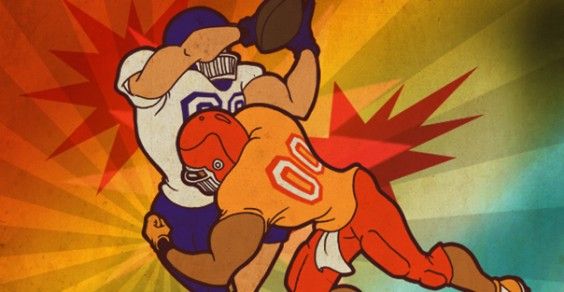We see it all the time: The NFL running back who’s tackled by a 270 pound linebacker; the ultra-marathoner who pounds through 100 miles of trails; and the soccer striker who battles injury and dominates the Olympic Games. So what helps athletes who get knocked down get back up again? Scientists have found compared to the average Joe, athletes certain cognitive strategies that help them deal with the pain.
Illustration by David Cushnie Bell
Pain Is Temporary, Pride Is Forever? — Why It Matters
A recent review in the (appropriately-named) journal Pain revealed what many have already guessed: Athletes can tolerate high levels of painPain perception in athletes compared to normally active controls: a systematic review with meta-analysis. Tesarz, J., Schuster, A.K., Hartmann, M., et al. Department of General Internal Medicine and Psychosomatics, Medical Hospital, University of Heidelberg, Germany. Pain, 2012 Jun;153(6):1253-62.. Researchers looked at 15 studies that examined pain threshold and tolerance in athletes and non-athletes. While both groups had similar pain thresholds (the point when pain is felt), athletes consistently tolerated more pain (the maximum amount one can handle before it becomes unbearable — fun!). Interestingly, many “game” sport athletes showed a higher pain tolerance than endurance athletes, although this varied by type of sport. (We’re guessing there was a different pain tolerance between wrestlers and bowlers.) Another study looked at gender and found male athletes tolerated pain better than womenThe influence of athletic status and gender on experimental pain responses. Manning, E.L., Fillingim, R.B. Psychology Department, Erskine College, Due West, SC. Journal of Pain, 2002 Dec;3(6):421-8.. But don’t fret ladies: That study sized maxed out at 48 people, so more research is probably needed before any conclusions can be drawn!
More clues point toward a common cognitive strategy athletes (often unknowingly) use: Association/DisassociationAthletes and pain tolerance. Pen, L.J., Fisher, C.A. Faculty of Nursing and Health Sciences, Griffith University, Gold Coast University College, Southport, Queensland, Australia. Sports Medicine, 1994 Nov;18(5):319-29.. Association is when people concentrate on the act itself (like dribbling a soccer ball or calculating running splits), while dissociation is when people think of something positive to distract them. (Man, the view beyond this football stadium is terrific.) Both strategies help increase pain tolerance and performance in athletes by reducing physiological stress. However, these strategies can be used to tackle the pain in different ways. Dissociation may increase pain threshold when working at a low to moderate intensity level, while association is more effective at higher intensitiesDo ‘mind over muscle’ strategies work? Examining the effects of attentional association and dissociation on exertional, affective and physiological responses to exercise. Lind, E., Welch, A.S., Ekkekakis, P. Department of Physical Education, State University of New York College at Oneonta, New York, New York. Sports Medicine, 2009;39(9):743-64.. Using these instinctive tactics may also vary by gender, as women tend to be more dissociative than menSex differences on use of associative and dissociative cognitive strategies among male and female athletes. Philippe, R.A., Seiler, R. Swiss Federal Institute of Sport Magglingen, 2532 Magglingen, Switzerland. Perception and Motor Skills, 2005 Oct;101(2):440-4..
No Pain, No Game — The Answer / Debate
The one thing missing from these studies is why athletes can handle the hurt. (We’re looking at you, Ironman athletes.) Researchers didn’t crack the code, but they suggest resistance to pain can be learned over time, and an increase in exercise intensity can lead to endorphin release. (Hello runner’s high!) Others suggest it’s because athletes are incredibly motivated to push through the pain in order to break a personal record, win a medal, or prove they’ve performed to the best of their ability.
Unfortunately, joining a kickball league won’t instantly make us power through the tough stuff. Pain tolerance depends on a range of factors, like genetics and the type of sportMarathon runners’ reaction to potassium iontophoretic experimental pain: pain tolerance, pain threshold, coping and self-efficacy. Johnson, M.H., Stewart, J., Humphries, S.A., et al. Department of Psychological Medicine, The University of Auckland, Auckland, New Zealand. European Journal of Pain, 2012 May;16(5):767-74 Epub 2011 Dec 19.Pain perception in athletes compared to normally active controls: a systematic review with meta-analysis. Tesarz, J., Schuster, A.K., Hartmann, M., et al. Department of General Internal Medicine and Psychosomatics, Medical Hospital, University of Heidelberg, Germany. Pain, 2012 Jun;153(6):1253-62.Individual differences in pain sensitivity: genetic and environmental contributions. Nielsen, C.S., Stubhaug, A., Price, D.D., et al. Division of Mental Health, Norwegian Institute of Public Health, P.O. Box 4404 Nydalen, NO-0403 Oslo, Norway. Pain, 2008 May;136(1-2):21-9. Epub 2007 Aug 9.. For example, researchers found people who carry a specific gene variant are more likely to report higher levels of pain, while contact-sport athletes may be able to grin and bear it more than others. One thing is pretty certain though — tolerating pain has a lot to do with mind over matter. So whether you’re a world-class athlete or a club frisbee fiend, when the goin’ gets tough, stick to positive thinking to help hurdle the discomfort.
This article has been read and approved by Greatist Experts Terra Castro and Phillip Page. Contributing research by Laura Skladzinski.
What’s your take on athletes and pushing through the pain? Share your thoughts in the comments below or tweet the author at @lschwech.


